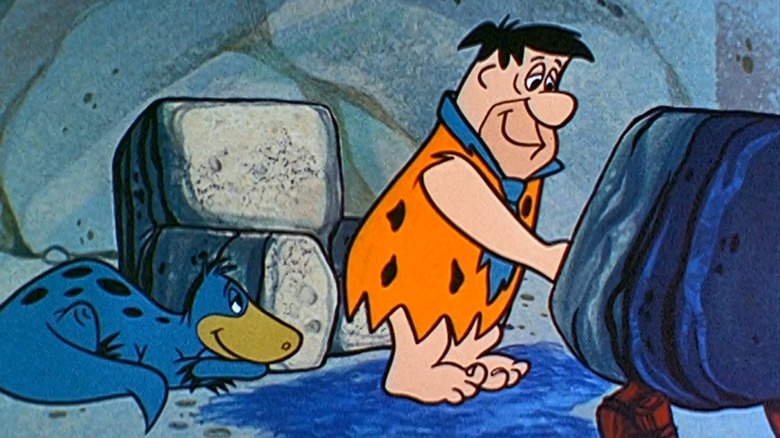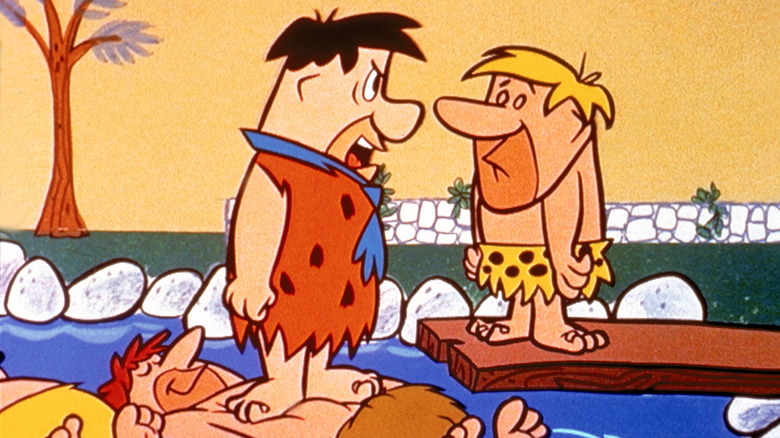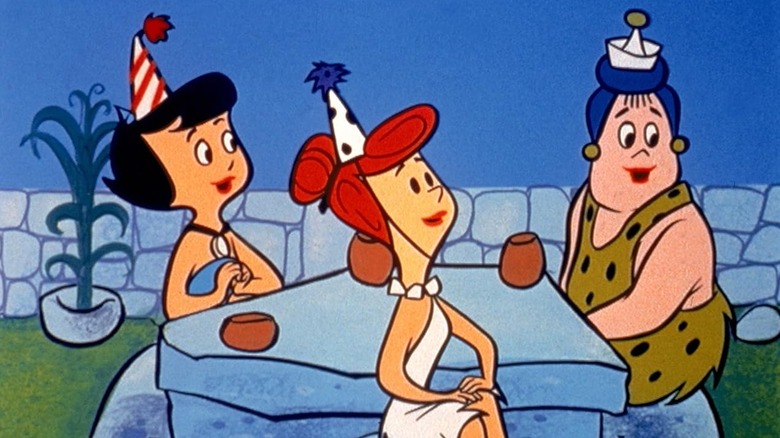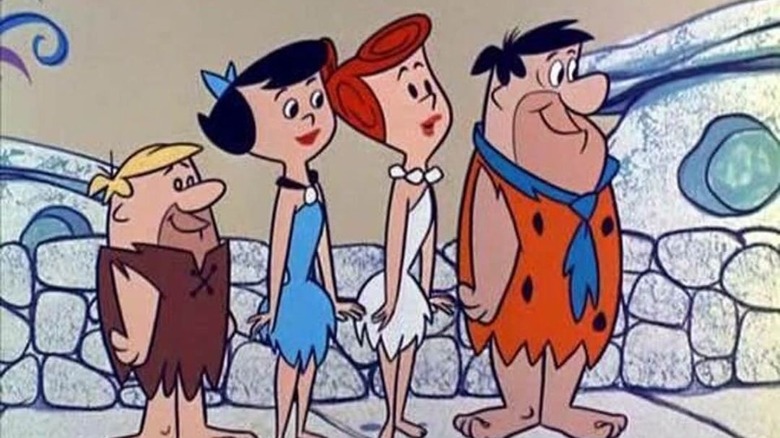The Flintstones Made TV History In The '60s Just By Existing
Will Hanna and Joe Barbera might be credited for popularizing a form of animation that allowed it to be produced at a tremendously rapid clip. Looking at the producing pair's early works like "The Huckleberry Hound Show" and "The Quick Draw McGraw Show," one can see "limited animation" at work. That is: characters were designed in such a way that only parts of them would need to be animated to complete a scene. Faces were conceived at three-quarters, letting characters look to the side or full front depending only on their eyes. Necks were covered by ascots or ties, allowing heads to be animated while bodies remained static.
Because of this design, Hanna-Barbera could produce multiple animated series on a notoriously fast TV production schedule. Hanna-Barbera exploded in the late 1950s, and dominated Saturday morning through the early 1980s.
The crown jewel in their output was, of course, "The Flintstones," which debuted on September 30, 1960 ... in primetime. Previously, animated shows typically ran in morning time slots, but Hanna and Barbera, wanting to shake off their reputation for being a "kiddie" studio, decided to pitch "The Flintstones" as a nighttime sitcom. The series is in the Guinness Book of World Records for its novel scheduling.
"The Flintstones" ran for a whopping six seasons and 166 episodes, a massive run for an animated show at the time. It held the record for the longest-running animated series of all time until it was unseated by "The Simpsons" in 1997. The show was not well-reviewed, but audiences loved the novelty, earning it high ratings for most of its runtime. Thereafter, "The Flintstones" was put into eternal syndication, allowing a younger generation to grow up on it.
The show is substantial.
The Honeymooners, 10,000 BC
For those who haven't absorbed "The Flintstones" by mere cultural osmosis, it was a series set in the Stone Age about the titular family of cave people. This was a fun, modern version of the Stone Age wherein humans had access to modern technology, but operated by trained birds, lizards, and dinosaurs. The vacuum cleaner was a tub attached to a zealous baby mammoth, for instance. Characters drove cars, but the cars were floorless, letting the driver push them along with their feet. The Flinstone patriarch was Fred (Alan Reed), a blue-collar stiff who worked in the nearby gravel pit, moving boulders with a trained brontosaurus. His wife, Wilma (Jean Vander Pyl) was a homemaker, and together they were raising a toddler, Pebbles (also Vander Pyl). Fred's best friend was Barney Rubble (Mel Blanc, Daws Butler occasionally), a kind but simple buddy, and Barney lived with his wife Betty (Bea Benaderet for the first four seasons, Gerry Johnson in its final two) and son Bamm-Bamm (Don Messick).
The characters, voices, and sitcom scenarios were lifted wholesale from the 1955 Jackie Gleason series "The Honeymooners," but also owes a creative debt to the 1946 radio comedy "The Bickersons." Jackie Gleason even once considered suing Hanna-Barbera for ripping off his idea, but knew the show was popular, and elected not to rain on anyone's parade (Gleason was also, in turn, sued by the makers of "The Bickersons" for ripping them off; Ecclesiastes 1:9). Joe Barbera contested the claim, saying that no one mentioned "The Honeymooners" during production. He was, however, fine with the interpretation. Because it drew from sources already edging out of hipness by the early 1960s, "The Flintstones" felt retro even at the time, causing critics to bristle at its contrived scripts and dumb plots.
Animation with a laugh track
To make "The Flintstones" feel more like an adult sitcom, Hanna-Barbera initially gave the series a pre-recorded laugh track, as if it were being filmed in front of a live studio audience. The canned laughter might sound strange to modern ears, but it separated "The Flinstones" from its animated brethren. Hanna-Barbera started including laugh tracks in other shows as well, although it would eventually abandon the practice.
There has long been a false piece of trivia circulating that Fred and Wilma Flintstone were the first couple on TV to be depicted sharing a bed. Thanks to the Hays code, there were strange rules about couples in relation to their beds. The Code dictated that a couple could kiss in bed, but at least one foot had to be on the floor. Also, if one party was laying down, the other had to be sitting up in the same bed. "The Flintstones" depicted the title couple as well as the Rubbles sharing a bed. This may seem scandalous, but by 1960, a lot of TV couples had ignored the rule. Indeed, TV historians have found that the title couple from "Mary Kay and Johnny" shared a bed as early as 1947. Couples also shared beds in "Ozzie and Harriet" in 1952, and in "I Love Lucy" in 1955.
Like "The Simpsons," "The Flintstones" attracted a lot of celebrity guests, or at least featured Stone Age versions of modern celebrities, each given a geology pun name. Ann-Margret played Ann-Margrock. Tony Curtis played Stony Curtis. Jimmy O'Neill played the uncreatively named Jimmy O'Neillstone. Punny celebrities have remained a regular feature of all future "Flintstones" spin-offs. To date, there have been ten "Flintstones" TV shows, three theatrical features, and 17 TV movies or specials.
The Stone Age will love forever
"The Flintstones" was also one of the few pre-"Star Wars" marketing bonanzas that really took off in earnest. The Flintstones faces made their way onto multiple grocery store products, some of which can be bought to this day; be sure to pick up some Flintstones Vitamins (launched in the late '60s), Fruity Pebbles (launched in 1971), or orange Push-Ups (c. 1990). Many modern kids have likely eaten the Flintstones foods without having seen the original TV series.
Which may be fine. Because "The Flintstones" was so dated when it premiered, it feels downright backward by today's standards. The men are all loutish, sawed-off dolts, and the women are all gossips and harridans. This author was born back in 1978, and my mother forbade "The Flintstones" in our household because it was blunt and sexist. She was right. Watching "Flintstones" reruns can be painful, especially if one was to find the old Winston Cigarette ads wherein Fred and Barney lit up a few smokes to relax.
Gen-X grew up with those reruns, and "The Flintstones" branded itself into their collective unconsciousness. There are multiple "Flintstones" references throughout "The Simpsons," for instance, and "Weird Al" Yankovic wrote a "Flintstones"-themed parody of Red Hot Chili Peppers' "Give It Away." The show's indelible theme song, written by Hoyt Curtain, regularly makes its way onto compilations of the best TV theme songs ever written, and one might recall hearing John Candy sing it in the film "Planes, Trains, and Automobiles."
"The Flintstones" wasn't just the first prime-time animated series, but it's a massive cultural force that we can't seem to shake. As of this writing, Elizabeth Banks is working on another animated reboot of "The Flintstones" called merely "Bedrock." The characters even appeared in season 3 of the Hanna-Barbera universe comedy, "Jellystone!"
It seems "The Flintstones" will never be done with us.



